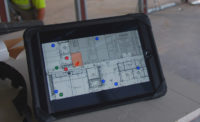I have just returned from the compact, intensely urbanized city of Hong Kong. The construction industry there is a cauldron of activity simmering on the fires of competition, political change, shifting economics and demographics, and further heated by the rapidly growing soft and hard linkages to the industries and population of mainland China.
These drivers are leading construction firms in Hong Kong to battle for advantage by leveraging process and technological innovation in a way that promises to set up the former British colony, with its history of internationalism as a crossroads of the Asian and Western worlds, as the hub of a construction technology revolution for the entire hemisphere.
Ever since the expiration of a 100-year lease to territory critical to Hong Kong’s viability as a colony in 1997 that made continuation of the British rule untenable, Hong Kong has been one of two “Special Administrative Regions” of the People’s Republic of China. It still retains its own currency and the border with the mainland is controlled, but the business ties began growing immediately between the two following the turnover 16 years ago. And now, as pressure builds on the construction industry of the mainland to shift from reliance on mass labor to higher productivity and efficiency, mainland firms are looking toward Hong Kong for ideas for process and technological advantage.
The construction software industry is responding. RIB Software AG, a German firm with international clientele and a Hong Kong-based CEO, Thomas Wolf, held a major product launch there in mid November of a 5D project execution platform named iTwo. The 5D process links 3D design to schedule and cost in an interactive environment so every proposed change in one dimension can be considered instantly for its impact on the other two.
I attended the two-day session, dubbed iTwo World, and listened to presentations by firms from Germany, Malaysia, Finland, Turkey, Singapore, Austria, Austria, China, Hong Kong and the U.S.A. that either had piloted projects on the iTwo platform, or were preparing to. The eagerness to embrace 5D technology in a bid to drive construction efficiency was palpable. In fact, at the end of the second day attendees signed a manifesto promoted by Wolf, proclaiming the start of a 5D revolution.
The iTwo product sandwiches a single-source-of-truth database between the end-to-end virtual processes of design, take-off, estimating, tendering, qualifying, bidding, project management, control and finance, and physical execution and offers a “control panel,” a role-specific dashboard view for stakeholders and participants. RIB claims iTwo has the ability to automatically generate bills of materials from IFC-compatible 3D models, and then leverage its own libraries as well as the localized, internal databases of users, to build and parametrically maintain cost estimates.
In the past year, RIB acquired two U.S. estimating software companies, MC2 and U.S. Cost, to gain their technologies, expertise and a foothold in the U.S. market.
And in a related move, RIB announced that it will open a facility in the mainland city of Guangzhou, about 75 miles northwest, that it will offer as a project set-up co-location facility for companies seeking to get a jump on iTwo project-supported implementation. The lab is in final stages of construction and will feature a battery of high-end technology and expertise in a luxury environment designed to entice companies to bring all of a project’s decision makers together and shut them in a room for days, en charrete, to hammer through the decision process to take virtual design as close to 100% as possible before releasing it for execution in the physical world.
But RIB is certainly not alone in sniffing the opportunity. The Hong Kong Housing Authority, which houses 30% of Hong Kong’s population of seven million in 730,000 public-housing rental flats, is driving hard in pushing its contractors to deliver all flavors of BIM-driven construction process advantage, including 5D and modular construction, in their tenders for the explosion of housing projects under way.
Remarkable efforts and results are being achieved by companies such as Yau Lee Holdings, one successful contender, which uses Vico for its 5D project platform, and which claims to have been the first Hong Kong construction company to reach across the border in 1997.



Post a comment to this article
Report Abusive Comment